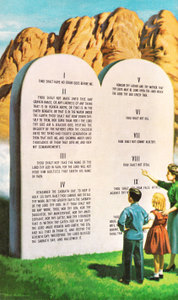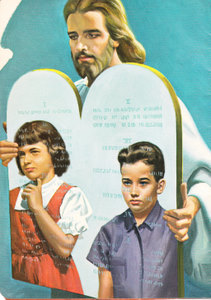A couple of weeks ago I had the awesome privilege of sharing part of my testimony of leaving Adventism with a group of ladies at church. Because I love media literacy so much, I wanted to show them how, through images and story, Adventist doctrines are taught to children. I also wanted to demonstrate how these beliefs shape the way Adventists think, believe, and relate to the world. Leaving Adventism is more than simply switching churches or denominations, it’s a complete worldview-shattering, foundation-shaking experience.
As a child, I absorbed the central importance of what Adventists call “The Law of God” through pictures. By “Law of God”, they mean the Ten Commandments and by “Ten Commandments”, they really mean the fourth commandment. This is because they believe that while nominal Christians might uphold every other commandment, true Christians will uphold all ten, including the fourth.
Take a look at these pictures.* What message do you think a child digests when pictures like these accompany text explaining the importance of the Sabbath and keeping the Ten Commandments?
The images below are usually used in adult Adventist literature to likewise convey the centrality of the Ten Commandment Law, but also to convey the Adventist belief that the Ten Commandments are “the basis of God’s covenant with His people and the standard of God’s judgement.” (See Fundamental Belief #19)
Is it any wonder that when sharing with an Adventist that the Old Covenant law is obsolete (Hebrews 8:13), cancelled (Hebrews 10:9) and ended (Ephesians 2:15), the very concept is unthinkable, preposterous, and absurd?
“So now there is no condemnation for those who belong to Christ Jesus. And because you belong to him, the power of the life-giving Spirit has freed you from the power of sin that leads to death. The law of Moses was unable to save us because of the weakness of our sinful nature. So God did what the law could not do. He sent his own Son in a body like the bodies we sinners have. And in that body God declared an end to sin’s control over us by giving his Son as a sacrifice for our sins. He did this so that the just requirement of the law would be fully satisfied for us, who no longer follow our sinful nature but instead follow the Spirit.” – Romans 8:1-4
*All pictures © Review & Herald Publishing Association. Used in accordance with fair use principles outlined in the U.S. copyright laws.
- The Promise That Led Us Out - December 26, 2024
- Does It Jibe with the Bible? - June 28, 2014
- Eyes to See, Not to Criticize - June 13, 2014





oh my… I had forgotten about the illustrations I saw over and over when I was a child. Now that time has passed since I have left the Adventist church, it’s interesting to see these again from a different perspective.
Out of the four illustrations you posted, the third one down made me very uncomfortable. The man’s head is lowered as if he is humbled or repenting before the Law. There is glowing rays emanating from the 10C’s. I’m assuming that is Jesus with His arm around this man and His other arm is UPLIFTED to the Law. There’s more realstate on the tablets given to the 4th commandment than any of the others. There are stairs leading UP to the Law which makes me think of we put important things up higher.
Why isn’t this man pictured as coming before God? Repenting and humbled before God? Glowing rays emanating from God? God raised UP on His throne?
… makes you wonder who their god really is.
vivian
Right, Vivian.
If you make a list of all the things the law stands for in SDA, and replace “law” with “God”, then it’s right.
It’s subtle but intentional.
All this makes the legend of the Prayer Garden outside Pioneer Memorial Church at Andrews University make sense. Here’s an excerpt from it:
Walking the garden’s edge, searching for a way in, we see the podium, an overlook where one can see across the water, through the arbor, and imagine God the Father represented in the ten commandments.…Ever narrowing, the winding path leads to the narrow gate with three crosses. Standing at the gate you are at the moment of decision to approach the foot of the cross. Between the gate and the cross is the Stair of Creation, one step for each day of creation. [Importantly, there are only six days of creation, not seven as found in this garden; God ceased from His work on the seventh.] The steps widen and were made a perfect number that it might seem easy to approach the cross. For once the decision is made for Christ, it is not so difficult….Standing at the foot of the Cross you imagine Christ…and looking up…you read the promise, “I Will Come Again”.…The Commandments beckon from across [the garden on the opposite wall]. It seems a long walk, like leaving earth, and entering the universe of the Creator. The path from the Cross leads directly to the Commandments…The Commandments stand at the center of the circle. Once within the circle, up close and intimate, we read what the hand of God wrote in millenniums past. Simple and embraced by the Father’s arms, intimate in His presence.
It’s completely backwards. The law leads the sinner to Jesus; when we receive Jesus, we can finally be united with our true Father. We don’t walk toward the law. We walk toward Jesus, and our lives are hidden with Him in God.
It *is* backwards, Colleen. And it keeps you in a cycle of never-good-enough, never realizing that in Christ we’re perfect. Stepping out of this thinking, it’s like stepping off a hamster wheel and stepping into real life.